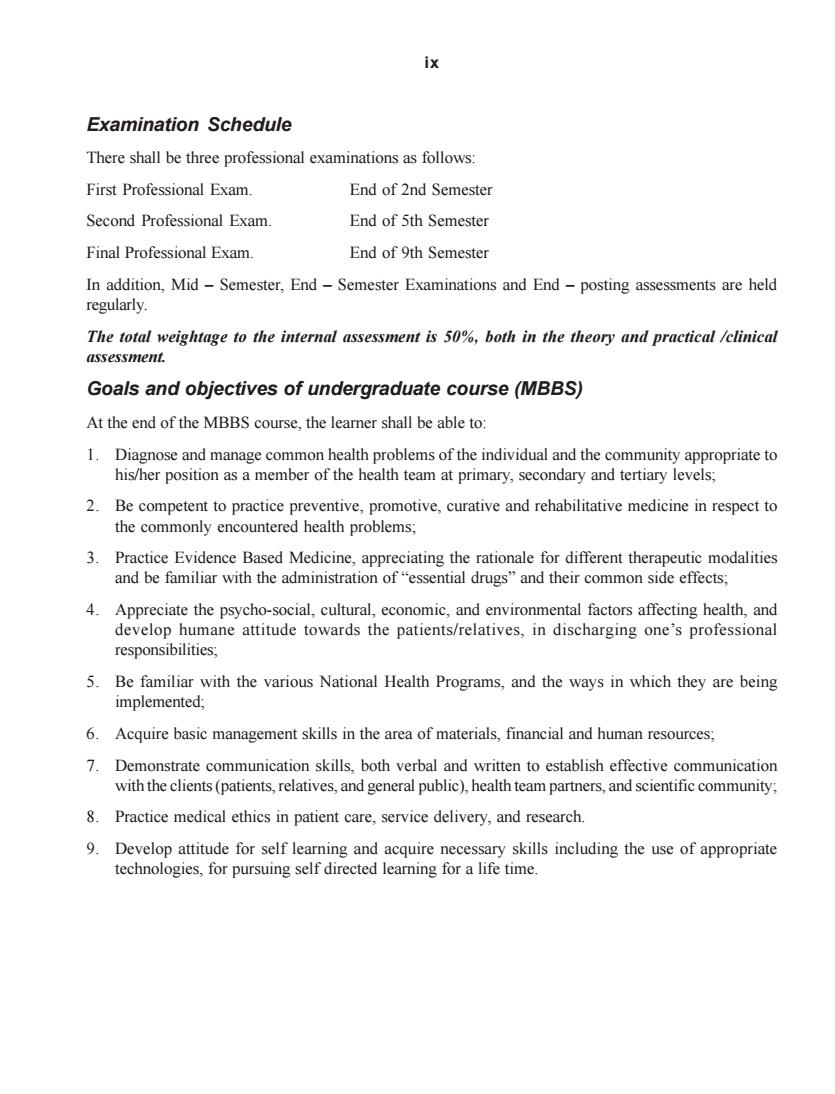
ixExaminationScheduleThere shall bethreeprofessional examinations as follows:FirstProfessionalExamEndof 2nd SemesterEndof 5thSemesterSecondProfessional ExamEnd of 9th SemesterFinal ProfessionalExam.In addition,Mid-Semester,End-SemesterExaminations and End-posting assessmentsareheldregularly.The total weightage to the internal assessment is 50%, both in the theory and practical /clinicalassessmentGoalsandobjectivesofundergraduatecourse(MBBS)AttheendoftheMBBScourse,thelearnershallbeableto:1.Diagnoseandmanagecommon healthproblemsofthe individual and the communityappropriatetohis/her position as a member of the health team at primary, secondary and tertiary levels;2.Becompetent topracticepreventive,promotive, curative and rehabilitative medicine in respecttothecommonlyencounteredhealthproblems;3.Practice Evidence Based Medicine, appreciating the rationalefor different therapeutic modalitiesand befamiliarwith the administration of"essential drugs"andtheir common sideeffects;4.Appreciatethepsycho-social,cultural,economic,and environmental factors affectinghealth,anddevelop humane attitude towards the patients/relatives, in discharging one's professionalresponsibilities,5.Be familiar with the various National Health Programs, and the ways in which they are beingimplemented,6.Acquire basic management skills in the area of materials, financial and human resources;7.Demonstratecommunicationskills,bothverbal andwrittentoestablisheffectivecommunicationwiththeclients(patients,relatives,andgeneral public),healthteam partners,andscientificcommunity;8元Practice medical ethics in patient care, service delivery, and research.9Develop attitude for self learning and acquire necessary skills including the use of appropriatetechnologies,forpursuingselfdirected learningfora lifetime
ix Examination Schedule There shall be three professional examinations as follows: First Professional Exam. End of 2nd Semester Second Professional Exam. End of 5th Semester Final Professional Exam. End of 9th Semester In addition, Mid – Semester, End – Semester Examinations and End – posting assessments are held regularly. The total weightage to the internal assessment is 50%, both in the theory and practical /clinical assessment. Goals and objectives of undergraduate course (MBBS) At the end of the MBBS course, the learner shall be able to: 1. Diagnose and manage common health problems of the individual and the community appropriate to his/her position as a member of the health team at primary, secondary and tertiary levels; 2. Be competent to practice preventive, promotive, curative and rehabilitative medicine in respect to the commonly encountered health problems; 3. Practice Evidence Based Medicine, appreciating the rationale for different therapeutic modalities and be familiar with the administration of “essential drugs” and their common side effects; 4. Appreciate the psycho-social, cultural, economic, and environmental factors affecting health, and develop humane attitude towards the patients/relatives, in discharging one’s professional responsibilities; 5. Be familiar with the various National Health Programs, and the ways in which they are being implemented; 6. Acquire basic management skills in the area of materials, financial and human resources; 7. Demonstrate communication skills, both verbal and written to establish effective communication with the clients (patients, relatives, and general public), health team partners, and scientific community; 8. Practice medical ethics in patient care, service delivery, and research. 9. Develop attitude for self learning and acquire necessary skills including the use of appropriate technologies, for pursuing self directed learning for a life time
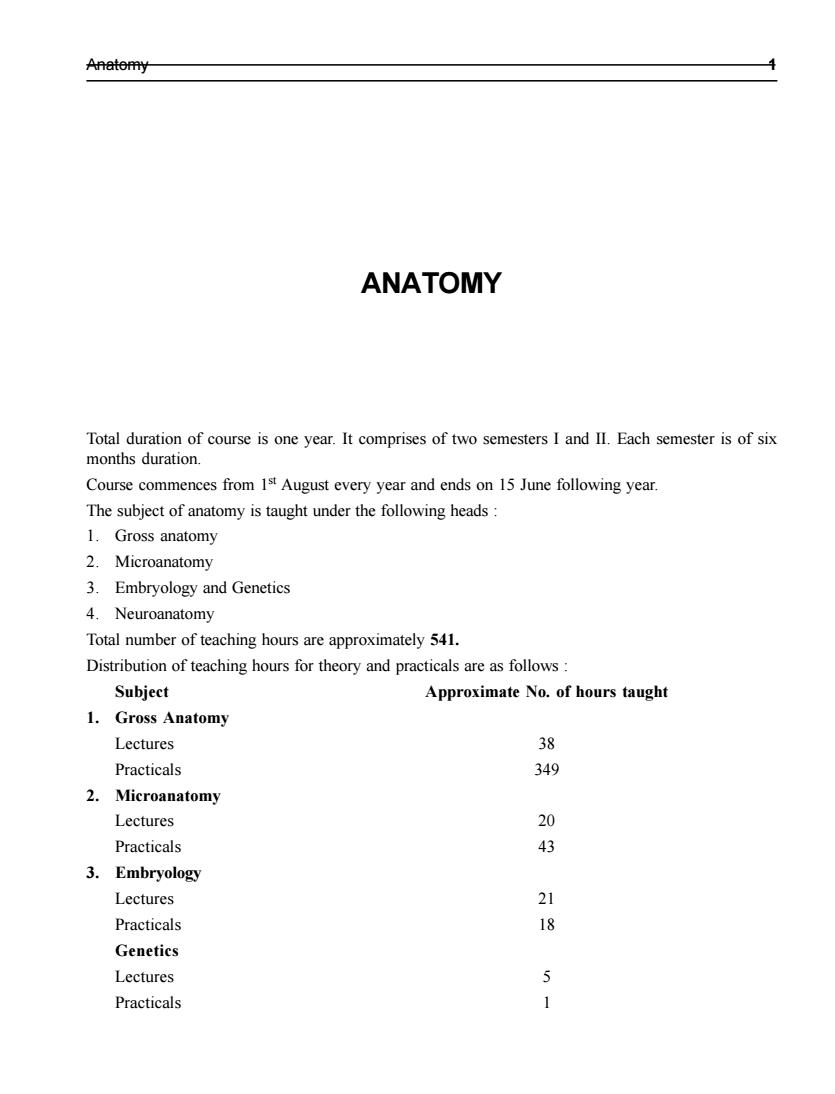
AnatomyANATOMYTotal duration of course is one year.It comprises of two semestersI and Il.Each semester is of sixmonths duration.Course commences from 1st August every year and ends on 15 June following year.Thesubjectof anatomyistaughtunderthefollowingheads:1.:Grossanatomy2.Microanatomy3.Embryology and Genetics4.NeuroanatomyTotalnumberofteachinghoursareapproximately541.Distributionofteachinghoursfortheoryandpracticals areasfollows:SubjectApproximateNo.ofhourstaught1.Gross Anatomy38Lectures349Practicals2.Microanatomy20Lectures43Practicals3.Embryology21Lectures18PracticalsGenetics5Lectures1Practicals
Anatomy 1 ANATOMY Total duration of course is one year. It comprises of two semesters I and II. Each semester is of six months duration. Course commences from 1st August every year and ends on 15 June following year. The subject of anatomy is taught under the following heads : 1. Gross anatomy 2. Microanatomy 3. Embryology and Genetics 4. Neuroanatomy Total number of teaching hours are approximately 541. Distribution of teaching hours for theory and practicals are as follows : Subject Approximate No. of hours taught 1. Gross Anatomy Lectures 38 Practicals 349 2. Microanatomy Lectures 20 Practicals 43 3. Embryology Lectures 21 Practicals 18 Genetics Lectures 5 Practicals 1
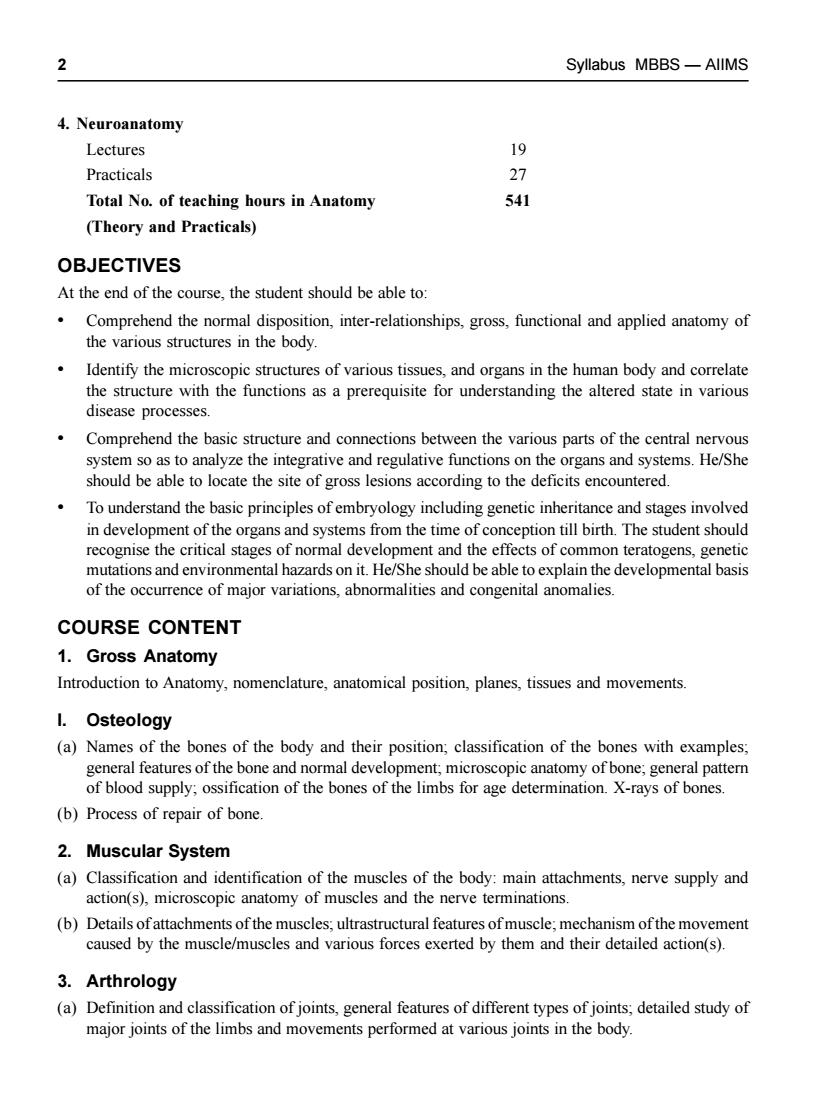
2Syllabus MBBS—AIIMS4.Neuroanatomy19Lectures27Practicals541Total No.of teaching hours inAnatomy(Theory and Practicals)OBJECTIVESAt the end of the course, the student should be able to:Comprehend the normal disposition, inter-relationships, gross, functional and applied anatomy of-thevarious structures inthe body.Identify the microscopic structures of various tissues, and organs in the human body and correlatethe structure with the functions as a prerequisite for understanding the altered state in variousdisease processes.Comprehend the basic structure and connections between the various parts of the central nervoussystem so as to analyze the integrative and regulative functions on the organs and systems.He/Sheshould be able to locate the site of gross lesions according to the deficits encountered.To understand the basic principles of embryology including genetic inheritance and stages involvedin developmentof the organs and systems from thetime of conception till birth.The student shouldrecognisethecritical stages of normal development and the effects of commonteratogens,geneticmutationsandenvironmentalhazardsonit.He/Sheshouldbeabletoexplainthedevelopmentalbasisoftheoccurrenceofmajorvariations,abnormalitiesand congenitalanomaliesCOURSECONTENT1.GrossAnatomyIntroductiontoAnatomy,nomenclature,anatomicalposition,planes,tissuesandmovements.I.Osteology(a)Names of the bones of the body and their position, classification of the bones with examples;general features ofthe bone and normal development,microscopic anatomy ofbone,general patternofblood supply,ossificationofthebonesof thelimbsforagedetermination.X-raysof bones.(b)Processof repairofbone.2.MuscularSystem(a) Classification and identification of the muscles of the body:main attachments, nerve supply andaction(s),microscopic anatomyof muscles andthenerveterminations.(b)Detailsofattachmentsofthemuscles;ultrastructuralfeaturesofmuscle;mechanismofthemovementcaused by the muscle/muscles and various forces exerted by them and their detailed action(s)3.Arthrology(a)Definition and classification of joints, general features of different types of joints, detailed study ofmajor joints of the limbs and movements performed at various joints in the body
2 Syllabus MBBS — AIIMS 4. Neuroanatomy Lectures 19 Practicals 27 Total No. of teaching hours in Anatomy 541 (Theory and Practicals) OBJECTIVES At the end of the course, the student should be able to: • Comprehend the normal disposition, inter-relationships, gross, functional and applied anatomy of the various structures in the body. • Identify the microscopic structures of various tissues, and organs in the human body and correlate the structure with the functions as a prerequisite for understanding the altered state in various disease processes. • Comprehend the basic structure and connections between the various parts of the central nervous system so as to analyze the integrative and regulative functions on the organs and systems. He/She should be able to locate the site of gross lesions according to the deficits encountered. • To understand the basic principles of embryology including genetic inheritance and stages involved in development of the organs and systems from the time of conception till birth. The student should recognise the critical stages of normal development and the effects of common teratogens, genetic mutations and environmental hazards on it. He/She should be able to explain the developmental basis of the occurrence of major variations, abnormalities and congenital anomalies. COURSE CONTENT 1. Gross Anatomy Introduction to Anatomy, nomenclature, anatomical position, planes, tissues and movements. I. Osteology (a) Names of the bones of the body and their position; classification of the bones with examples; general features of the bone and normal development; microscopic anatomy of bone; general pattern of blood supply; ossification of the bones of the limbs for age determination. X-rays of bones. (b) Process of repair of bone. 2. Muscular System (a) Classification and identification of the muscles of the body: main attachments, nerve supply and action(s), microscopic anatomy of muscles and the nerve terminations. (b) Details of attachments of the muscles; ultrastructural features of muscle; mechanism of the movement caused by the muscle/muscles and various forces exerted by them and their detailed action(s). 3. Arthrology (a) Definition and classification of joints, general features of different types of joints; detailed study of major joints of the limbs and movements performed at various joints in the body
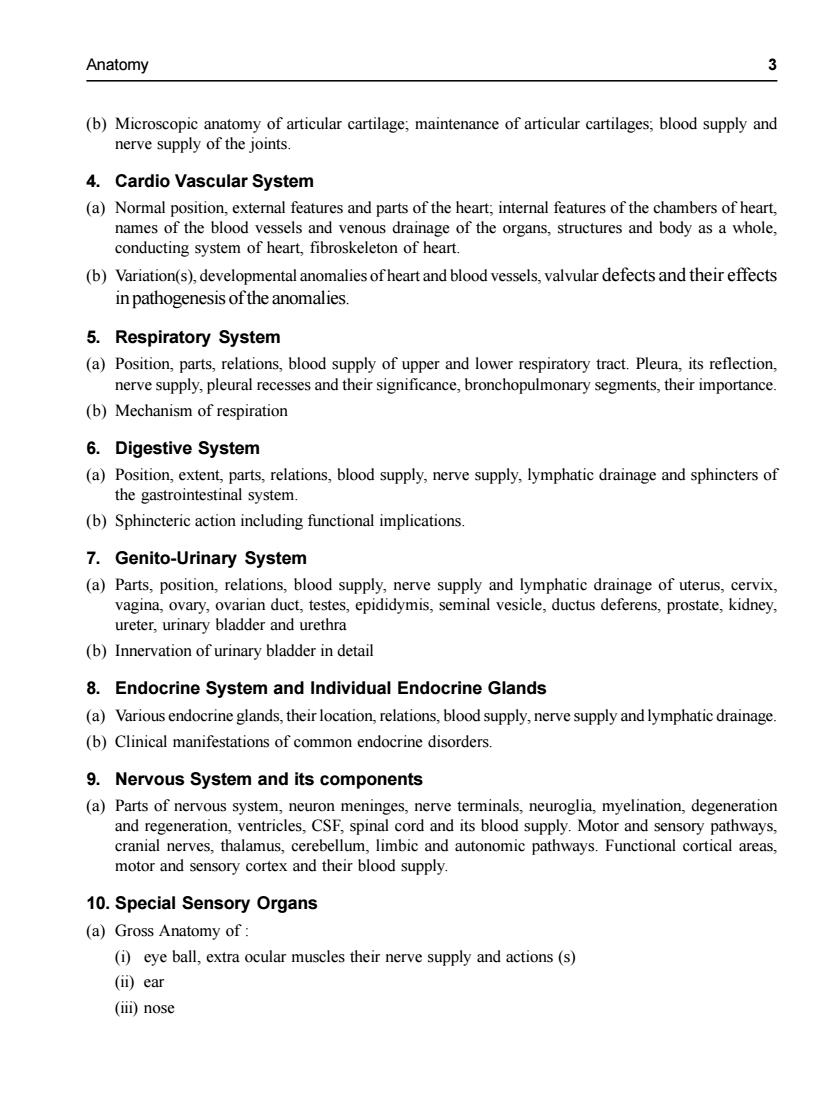
3Anatomy(b)Microscopic anatomy of articular cartilage; maintenance of articular cartilages; blood supply andnerve supplyofthe joints.4.CardioVascularSystem(a)Normal position, external features and parts of the heart, internal features of the chambers of heart,names of the blood vessels and venous drainage of the organs, structures and body as a whole,conducting system of heart, fibroskeleton of heart.(b)Variation(s),developmental anomalies ofheart and blood vessels,valvular defects and their effectsinpathogenesisoftheanomalies.5.RespiratorySystem(a) Position, parts, relations, blood supply of upper and lower respiratory tract. Pleura, its reflection,nervesupply,pleuralrecessesandtheirsignificance,bronchopulmonarysegments,theirimportance(b)Mechanismofrespiration6.DigestiveSystem(a) Position, extent, parts, relations, blood supply, nerve supply, lymphatic drainage and sphincters ofthegastrointestinal system.(b)Sphinctericactionincludingfunctional implications.7.Genito-UrinarySystem(a) Parts, position, relations, blood supply,nerve supply and lymphatic drainage of uterus, cervix,vagina, ovary, ovarian duct, testes, epididymis, seminal vesicle, ductus deferens, prostate, kidney,ureter, urinarybladder and urethra(b)Innervation of urinary bladder in detail8.EndocrineSystemandIndividualEndocrineGlands(a)Various endocrine glands, their location, relations, blood supply,nerve supply and lymphatic drainage(b)Clinical manifestations of common endocrinedisorders.9.NervousSystemanditscomponents(a)Parts of nervous system, neuron meninges, nerve terminals, neuroglia, myelination, degenerationand regeneration,ventricles,CSE, spinal cord and its blood supply.Motorand sensorypathways,cranial nerves,thalamus,cerebellum, limbic andautonomic pathways.Functional cortical areas,motor and sensory cortex and their blood supply.10.SpecialSensoryOrgans(a)Gross Anatomy of:(i) eye ball, extra ocular muscles their nerve supply and actions (s)(i) ear(ii) nose
Anatomy 3 (b) Microscopic anatomy of articular cartilage; maintenance of articular cartilages; blood supply and nerve supply of the joints. 4. Cardio Vascular System (a) Normal position, external features and parts of the heart; internal features of the chambers of heart, names of the blood vessels and venous drainage of the organs, structures and body as a whole, conducting system of heart, fibroskeleton of heart. (b) Variation(s), developmental anomalies of heart and blood vessels, valvular defects and their effects in pathogenesis of the anomalies. 5. Respiratory System (a) Position, parts, relations, blood supply of upper and lower respiratory tract. Pleura, its reflection, nerve supply, pleural recesses and their significance, bronchopulmonary segments, their importance. (b) Mechanism of respiration 6. Digestive System (a) Position, extent, parts, relations, blood supply, nerve supply, lymphatic drainage and sphincters of the gastrointestinal system. (b) Sphincteric action including functional implications. 7. Genito-Urinary System (a) Parts, position, relations, blood supply, nerve supply and lymphatic drainage of uterus, cervix, vagina, ovary, ovarian duct, testes, epididymis, seminal vesicle, ductus deferens, prostate, kidney, ureter, urinary bladder and urethra (b) Innervation of urinary bladder in detail 8. Endocrine System and Individual Endocrine Glands (a) Various endocrine glands, their location, relations, blood supply, nerve supply and lymphatic drainage. (b) Clinical manifestations of common endocrine disorders. 9. Nervous System and its components (a) Parts of nervous system, neuron meninges, nerve terminals, neuroglia, myelination, degeneration and regeneration, ventricles, CSF, spinal cord and its blood supply. Motor and sensory pathways, cranial nerves, thalamus, cerebellum, limbic and autonomic pathways. Functional cortical areas, motor and sensory cortex and their blood supply. 10. Special Sensory Organs (a) Gross Anatomy of : (i) eye ball, extra ocular muscles their nerve supply and actions (s) (ii) ear (iii) nose
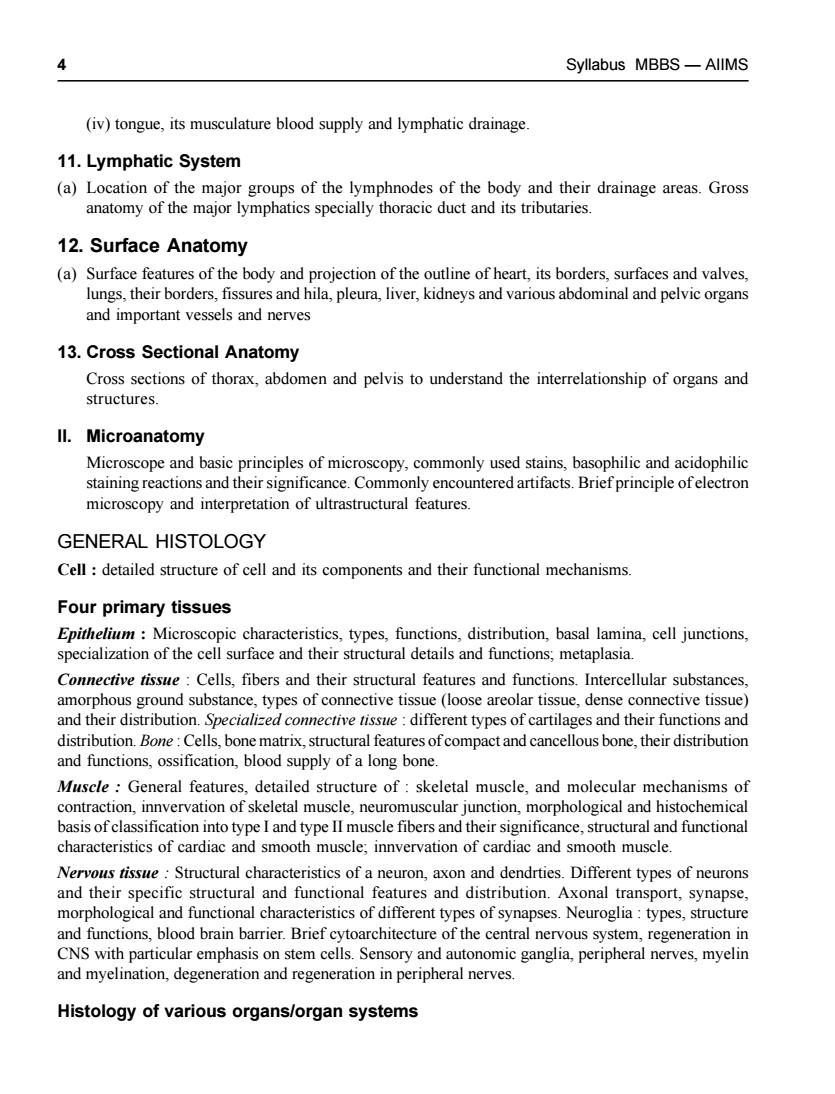
4Syllabus MBBS—AIIMS(iv)tongue, its musculatureblood supply and lymphatic drainage11.LymphaticSystem(a) Location of the major groups of the lymphnodes of the body and their drainage areas. Grossanatomy of the majorlymphatics specially thoracic ductand its tributaries.12.SurfaceAnatomy(a) Surface features of the body and projection of the outline of heart, its borders, surfaces and valves.lungs, their borders, fissures and hila, pleura, liver, kidneys and various abdominal and pelvic organsand important vessels and nerves13.CrossSectionalAnatomyCross sections of thorax, abdomen and pelvis to understand the interrelationship of organs andstructures.II.MicroanatomyMicroscopeandbasicprinciplesofmicroscopy,commonlyused stains,basophilicandacidophilicstainingreactions and their significance.Commonlyencountered artifacts.Brief principleofelectronmicroscopyandinterpretationofultrastructuralfeaturesGENERALHISTOLOGYCell :detailed structure of cell and its components and their functional mechanisms.FourprimarytissuesEpithelium : Microscopic characteristics, types, functions, distribution, basal lamina, cell junctions.specialization of the cell surface and their structural details and functions, metaplasia.Connective tissue:Cells,fibers and their structural features and functions.Intercellular substances,amorphousgroundsubstance,typesofconnectivetissue(looseareolartissue,denseconnectivetissue)and their distribution.Specialized connective tissue:differenttypes ofcartilages and theirfunctions anddistribution.Bone:Cells,bonematrix,structuralfeatures ofcompactand cancellous bone,theirdistributionandfunctions, ossification,blood supplyof a longbone.Muscle : General features, detailed structure of : skeletal muscle, and molecular mechanisms ofcontraction,innvervation of skeletal muscle,neuromuscular junction,morphological and histochemicalbasis of classification into typeIand typeII musclefibers and their significance,structural and functionalcharacteristics of cardiac and smooth muscle; innvervation of cardiac and smooth muscle.Nervous tissue : Structural characteristics of a neuron, axon and dendrties.Different types of neuronsand their specific structural and functional features and distribution.Axonal transport, synapse,morphological andfunctional characteristics of differenttypes of synapses.Neuroglia:types,structureand functions,blood brainbarrier.Brief cytoarchitectureofthe central nervous system,regeneration inCNSwithparticularemphasison stemcells.Sensoryandautonomicganglia,peripheralnerves,myelinandmyelination,degenerationand regeneration inperipheral nerves.Histologyofvariousorgans/organsystems
4 Syllabus MBBS — AIIMS (iv) tongue, its musculature blood supply and lymphatic drainage. 11. Lymphatic System (a) Location of the major groups of the lymphnodes of the body and their drainage areas. Gross anatomy of the major lymphatics specially thoracic duct and its tributaries. 12. Surface Anatomy (a) Surface features of the body and projection of the outline of heart, its borders, surfaces and valves, lungs, their borders, fissures and hila, pleura, liver, kidneys and various abdominal and pelvic organs and important vessels and nerves 13. Cross Sectional Anatomy Cross sections of thorax, abdomen and pelvis to understand the interrelationship of organs and structures. II. Microanatomy Microscope and basic principles of microscopy, commonly used stains, basophilic and acidophilic staining reactions and their significance. Commonly encountered artifacts. Brief principle of electron microscopy and interpretation of ultrastructural features. GENERAL HISTOLOGY Cell : detailed structure of cell and its components and their functional mechanisms. Four primary tissues Epithelium : Microscopic characteristics, types, functions, distribution, basal lamina, cell junctions, specialization of the cell surface and their structural details and functions; metaplasia. Connective tissue : Cells, fibers and their structural features and functions. Intercellular substances, amorphous ground substance, types of connective tissue (loose areolar tissue, dense connective tissue) and their distribution. Specialized connective tissue : different types of cartilages and their functions and distribution. Bone : Cells, bone matrix, structural features of compact and cancellous bone, their distribution and functions, ossification, blood supply of a long bone. Muscle : General features, detailed structure of : skeletal muscle, and molecular mechanisms of contraction, innvervation of skeletal muscle, neuromuscular junction, morphological and histochemical basis of classification into type I and type II muscle fibers and their significance, structural and functional characteristics of cardiac and smooth muscle; innvervation of cardiac and smooth muscle. Nervous tissue : Structural characteristics of a neuron, axon and dendrties. Different types of neurons and their specific structural and functional features and distribution. Axonal transport, synapse, morphological and functional characteristics of different types of synapses. Neuroglia : types, structure and functions, blood brain barrier. Brief cytoarchitecture of the central nervous system, regeneration in CNS with particular emphasis on stem cells. Sensory and autonomic ganglia, peripheral nerves, myelin and myelination, degeneration and regeneration in peripheral nerves. Histology of various organs/organ systems